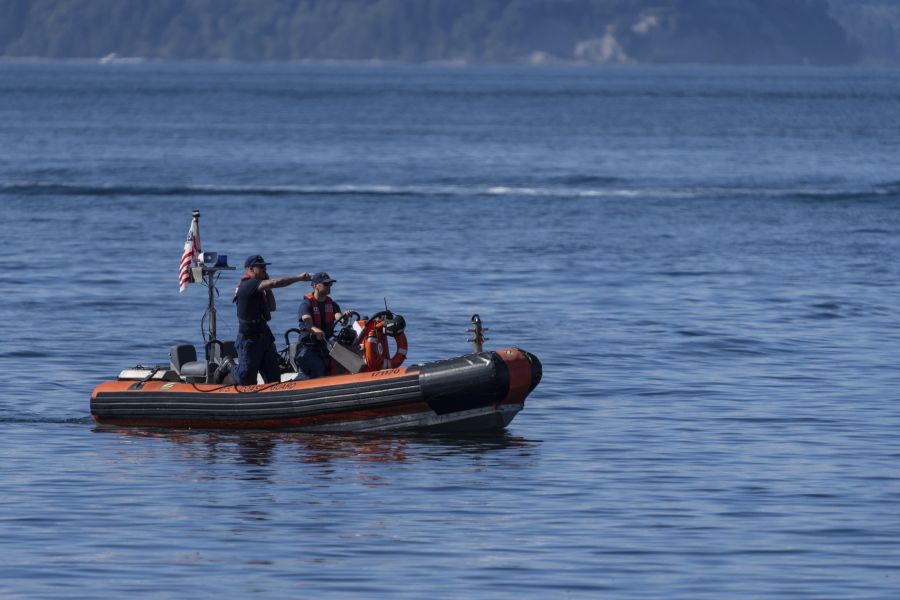SEATTLE — Most of a plane that crashed into Mutiny Bay over Labor Day weekend, killing 10 people, has been recovered, according to the National Transportation Safety Board.
About 80 percent of the plane, including the engine, has been recovered and pulled to the surface using remotely operated vessels, NTSB Chair Jennifer Homendy said Thursday. Homedy is among the crew on barges leading recovery efforts that began Tuesday in a shipping channel off Whidbey Island.
An NTSB spokesperson said only the Island County Coroner could share details on the recovery of human remains. The coroner’s office did not immediately respond to requests for additional information Thursday afternoon.
The plane was a de Havilland DHC-3 Otter, a regular in the Seattle area’s floatplane ecosystem, bound from Friday Harbor to Renton on Sept. 4, before plummeting into the water, causing a large splash and a loud boom,
Onlookers and first responders in the immediate aftermath found only small pieces of potential debris, a few personal items and the body 29-year-old Gabby Hanna, with no trace of the other nine people aboard the plane.
As of Thursday afternoon, Homendy said crews had located and were working to bring up one wing and several flight control pieces including a horizontal stabilizer and both of the plane’s control elevators. Crews have identified the propeller and the gear box and are looking for the ailerons, which control the roll of the plane.
Seeking to recover the “four corners” of the airplane — the nose, the tail and both wings — Homendy said crews are pleased with the progress made in slightly more than 48 hours of ROV recovery, and would likely halt the operation in the next couple of days.
“The recovery operation for wreckage is going really well,” Homendy said, noting that crews of between 20-23 NTSB, Navy, Island County Sheriff and subcontractors have been working in 12-hour shifts around the clock since Tuesday.
Despite dozens of witnesses narrowing down the crash site, it took officials more than a week and multiple types of sonar to locate the plane because of the depth and current of the channel in Mutiny Bay. Recovery efforts began Tuesday, with ROVs plunging more than 150 feet below the surface to retrieve the wreckage.
Homendy said the recovery is halted for some hours of the day because of powerful currents under the surface.
“There are hours where we cant have the ROV in the water because we can’t move it forward,” she said, noting crews have to wait for “slack tide,” or a period when there is limited or no horizontal movement in the water, to resume efforts.
Once the recovery is complete, NTSB will layout wreckage in a secure location and experts will begin combing through debris to find potential causes.
The process can take between 12 to 24 months, according to Homendy, as the NTSB assesses “man, machine and environment” to determine probable cause of the fatal crash.
In the meantime, she noted, the NTSB will share any potential urgent safety information with the Federal Aviation Administration, including if they have reason to be concerned about any particular part on the de Havilland Canada DHC-3 Otter.
“If we have a concern regarding the fleet, we’re going to do something. We’re not going to wait,” Homendy said.
NTSB officials released a preliminary report that noted the plane had undergone a 100-hour inspection — a routine examination done every 100 flight hours — just three days before the incident and had completed a trip earlier the same day. It could take up to two years for investigators to determine the cause of the accident.
According to the report, inspections were completed in August and September of the control column lower assembly and elevator control tabs, as required by FAA airworthiness directives.
In 2004, the FAA established a directive for the elevator control tabs — small hinge mechanisms that contribute to the plane’s elevator system, which helps a pilot control the plane’s pitch, or the vertical movement of the nose. It came after reports that the control rod to the elevator servo-tab system could detach from the tab, causing the servo tab to “flutter” on DHC-3 Turbine Otter floatplanes with a turbine engine installed.
The fluttering servo tab has been linked to multiple DHC-3 crashes.
Investigators will use additional evidence from the wreckage to conduct the full investigation, which can take up to 24 months. Limited additional data may be available from the plane.



